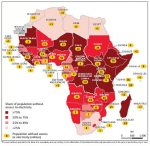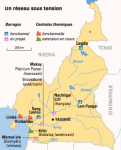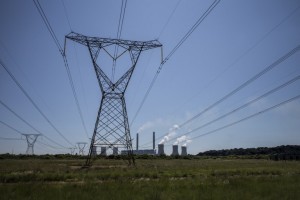The development of Africa is conditioned by access to electricity. This access is unfortunately heterogeneous in the continent. Indeed, North Africa and South Africa have an access rate higher than 75%. However, the countries of sub-Saharan Africa (SSA) have a rate of access that does not exceed 50% and for some even does not exceed 15%. This is what we would call the “energy paradox of sub-Saharan Africa”. Some countries in this region of Africa benefit from renewable energy sources and exceptional raw materials. Hydroelectricity: DRC (with a potential of 180 GW), wind and geothermal (Kenya), solar and biomass (whole Africa).

Figure 1 Access to electricity in Africa (International Energy Agency 2014)
Energy situation of sub-Saharan Africa
Example of Ivory Coast
According to the International Energy Agency (IEA), in 2014 Côte d’Ivoire’s electrification rate was between 15 and 50%. Today the Ivorian electricity company (CIE) announces a rate of 80% and ambition a rate of 100% by 2025. Several isolated populations remain without access to electricity, which is why the Ivorian state is conducting a rural electrification project in partnership with the CIE with the aim of electrifying by 2020 all the villages of more than 500 inhabitants. This decentralized electrification will be done using solar panels.
Example of Cameroon
Cameroon, like many SSA countries, has a bad energy mix. And this situation does not promote access to electricity for the population in particular. In fact, nearly 73% of the country’s electricity production is made using hydroelectric power stations. A solution that requires having significant transport and distribution infrastructure. In addition the period of low water (period during which the flow of a watercourse decreases) causes load shedding. The country’s electricity production (including thermal) is 1.3 GW. What remains very insufficient in relation to demand.

Figure 2 Hydropower plants in Cameroon (2017)
Example from Kenya
Kenya is located east of the African continent and enjoys interesting geothermal energy. (see Fig 3). The country also has good renewable energy potential.

Figure 3 Geothermal energy in the world
Geothermal energy and wind power through biomass could improve the country’s electricity generation capacity. The use of solar energy too, especially in rural areas that are disconnected from the electricity grid.
Example of the DRC
According to many opinions the DRC is the richest country in Africa, but paradoxically it is one of the poorest countries in the world. Yet this country is full of mineral resources: cobalt (60% of world production), coltan (80% of world production), copper (4% of world production), it is recalled that because of its good electrical resistivity, the Copper is used in the manufacture of high voltage lines for the transmission of electricity. There is also diamond, gold zinc … etc. Finally, the country’s hydroelectric potential is phenomenal. About 180 GW or 180 nuclear reactors. The Congo River has a flow of about 41 000 m3 / s. This country could electrify the whole region. The INGA project (11000 MW installed capacity is planning to power South Africa (2500MW) which has serious energy problems.
Example from Rwanda
Lake Kivu, located to the west of Rwanda, which shares a border with the DRC, is one of the three lakes in the world containing the highest concentration of methane. This gas poses a potential threat to the populations. Rwanda has decided to extract this gas to produce electricity. The water is extracted at nearly 300 meters deep. The gas is then separated from the water. Carbon dioxide and water are released into the lake. The separated methane is then sent directly to a power plant where it is used to generate electricity. 1/3 of the country’s electricity demand is supported by this plant.
Some orientations to the continent’s electricity deficit
Several electrification projects are initiated here and there across the continent. But the electrification of Africa will not happen without looking at these six main points:
Governance / management / leadership
In the majority of cases in sub-Saharan Africa energy policy choices are driven by heads of state, management by ministers and leadership by business leaders. These points are to be improved in sub-Saharan Africa. Unfortunately, corruption adds to the ills that hinder good management and decisions on energy policies and guidelines.
Education and training
Population education is generally an important factor for the development of a country. A strong education induces a strong human development. And that improves the economic development of the country. A simple example is the education of populations on the selective sorting of waste. The use of organic waste (biomass) for energy production is a sustainable solution for SSA countries. Training of company employees in the use of renewable energy technologies would enable companies to reduce their energy bills.
The energy mix
The energy mix is the set of solutions used for energy production. In most SSA countries the energy mix is not good. The production of electrical energy is done by large hydroelectric plants. It should be noted that this production is centralized and thus requires suitable and maintained transport infrastructure. Decentralized production would enable rural people to benefit from electricity.
Power grids
In SSA the electrical networks, when they are not non-existent, are very old and unkept. Training of line maintenance personnel (high and low voltage) must be done. The improvement of the management of the electricity network must be done with the aim of respecting the fundamental rule of the electrical networks which is “At every moment, the electricity production must be equal to the consumption”.
The processing of raw materials
The processing of raw materials is an important step for the economic development of a country and especially the construction of high and low voltage lines of the electricity network. An electrical network line is made of copper or aluminum for the electrical conduction part, coated with polyethylene for the neutral part and then with a layer of steel alloy for the mechanical strength of the structure.
The CFA franc
Several books are destined to the question of the FCFA (The CFA Franc and the euro against Africa, 28 February 2000 of Nicolas Agbohou and Grégoire Biyogo and the Franc Cfa, a currency without legal base of Uemoa and Cemac 5 December 2016 of Lawal Adoulaye Ibrahima).
This currency has characteristics that do not allow the necessary investments and moreover stowage to the Euro does not allow sufficient flexibility for exports and imports. 15 SSA countries should exit the FCFA to improve their access to electricity. In fact, West and Central African countries have a credit rate of 25% and 15% respectively of GDP (for comparison in France it is 100% and in the USA it is higher than 100% GDP). Moreover in the FCFA countries 98% of the credits granted are for a duration of less than 2 years whereas we know that a minimum duration of 7 years is recommended to boost the economy. The investments needed for the electricity infrastructure can not be made.


Leave a Reply